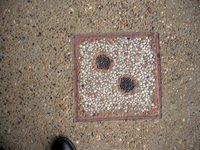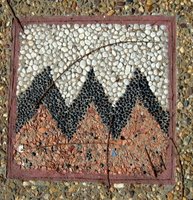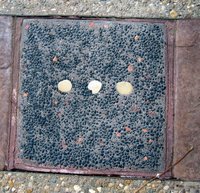Not everyone struck it rich during the Gold Rushes in Australia. In fact, the majority found little or no gold, arriving too late as each new field opened up. Men carried their 'swags' (or bedding rolled up like a fat cigar) along the dusty roads, usually flat broke and looking for a handout. After the last gold rushes in the 1860s and 1870s, we drifted into the long drought of the 1880s and a slump in wool prices, followed by a damaging shearers' strike (the woolgrowers tried to cut their rates) which led to the formation of the Australian Labor Party. (We can thank woolgrowers for the ALP.) By the early 1890s the colonies were in the grip of a long depression, and 40 years later came the Great Depression of the 1930s. A lot of people went 'on the wallaby track' (hit the road in search of work or a handout). Australia has long had a tradition os the 'swagman', an itinerant worker/drifter who lived rough and entered the mythology of the nation in the 1890s when bush poet Banjo Paterson wrote "Walzing Matilda" (now the country's unofficial anthem).These people of the road had their own language and signs to indicate to each other what conditions were like at the next farm house. They would scratch symbols in the dust of the road or lay twigs out on the ground. A number of these symbols have been reproduced in the pavements in the streets of historic Gulgong, our nearest township. This idea was Chester Nealie's; he's a local potter, who conducted research at Sydney University. It's a great way to keep the past alive. A nation that forgets its past has no future, I say. (I studied Australian history at the University of New England in Armidale and taught it at Charles Sturt University in Bathurst.)

TWO DOTS OR SMALL CIRCLES meant "Tell a pathetic story and you'll get a handout."

JAGGED LINES meant "Angry dogs"

TRIDENT meant "You have to work before you eat"

THREE DOTS OR SMALL CIRCLES MEANT "Money usually given here."
 TWO DOTS OR SMALL CIRCLES meant "Tell a pathetic story and you'll get a handout."
TWO DOTS OR SMALL CIRCLES meant "Tell a pathetic story and you'll get a handout." JAGGED LINES meant "Angry dogs"
JAGGED LINES meant "Angry dogs" TRIDENT meant "You have to work before you eat"
TRIDENT meant "You have to work before you eat" THREE DOTS OR SMALL CIRCLES MEANT "Money usually given here."
THREE DOTS OR SMALL CIRCLES MEANT "Money usually given here."
 TWO DOTS OR SMALL CIRCLES meant "Tell a pathetic story and you'll get a handout."
TWO DOTS OR SMALL CIRCLES meant "Tell a pathetic story and you'll get a handout." JAGGED LINES meant "Angry dogs"
JAGGED LINES meant "Angry dogs" TRIDENT meant "You have to work before you eat"
TRIDENT meant "You have to work before you eat" THREE DOTS OR SMALL CIRCLES MEANT "Money usually given here."
THREE DOTS OR SMALL CIRCLES MEANT "Money usually given here."




2 comments:
Hello!
Very interesting site, beautiful design, thank.
89.com gallery sex ics
adult xxx women trailers
amateur blogs sex pic
angelina jolie haveing sex
asian nude beaches .com
thank
Nikolaus Gerber
Excellent, love it! home remedies lower cholesterol Fax and voice messaging faxtalk messenger pro Toyota dealers oregon Aol block popups http://www.levitra-5.info/craps-serial-number-windows-2003-server.html Card free graphic greeting 1972 vw westfalia Electronic data systems class action viagra used casino craps table http://www.poker-3.info/Cheerleader-craps-games-demo.html dvb video card White woman dating black man garrett wyoming http://www.digital-print-service.info/Digital_t_shirt_printing_chicago.html Casino craps gambling online tip craps Men's wide width dance shoes
Post a Comment